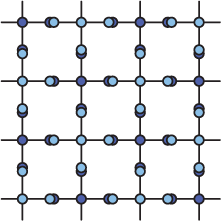Yb hybrid tweezer-lattice
We are developing a novel experimental platform for quantum simulation with ultracold fermionic Yb atoms. Our main goal is to realize novel techniques for local control in optical lattices by combining optical lattices with optical tweezer arrays.
Quantum simulation of lattice gauge theories
 Gauge theories play a fundamental role for our understanding of nature, ranging from high-energy physics to condensed matter. Their formulation on a regularized periodic lattice geometry, so-called lattice gauge theories (LGTs), has proven invaluable for theoretical studies. However, there exist severe limitations regarding the simulation of real-time dynamics and of systems with finite chemical potential, leaving many important questions unanswered. Recent advances in the controllability of quantum many-body systems have sparked increased interest in quantum simulation of LGTs. In these systems, non-equilibrium phenomena and real-time dynamics are routinely studied over a wide range of parameters. Despite their success, significant progress in simulating LGTs is hindered by the lack of local gauge invariance, which does not naturally occur in these systems. In order to overcome this challenge, we propose to combine ultracold atoms in optical lattices with tweezer arrays, thus uniting global defect-free lattices with precise local control, which in turn allows us to impose local gauge invariance via energy penalties. More specifically, our platform will enable the study of U(1) lattice gauge theories coupled to fermionic matter in one- and two-dimensions.
Gauge theories play a fundamental role for our understanding of nature, ranging from high-energy physics to condensed matter. Their formulation on a regularized periodic lattice geometry, so-called lattice gauge theories (LGTs), has proven invaluable for theoretical studies. However, there exist severe limitations regarding the simulation of real-time dynamics and of systems with finite chemical potential, leaving many important questions unanswered. Recent advances in the controllability of quantum many-body systems have sparked increased interest in quantum simulation of LGTs. In these systems, non-equilibrium phenomena and real-time dynamics are routinely studied over a wide range of parameters. Despite their success, significant progress in simulating LGTs is hindered by the lack of local gauge invariance, which does not naturally occur in these systems. In order to overcome this challenge, we propose to combine ultracold atoms in optical lattices with tweezer arrays, thus uniting global defect-free lattices with precise local control, which in turn allows us to impose local gauge invariance via energy penalties. More specifically, our platform will enable the study of U(1) lattice gauge theories coupled to fermionic matter in one- and two-dimensions.
Atom-by-atom assembly in optical lattices
Traditionally, quantum simulation experiments with ultracold atoms start by preparing degenerate quantum gases in optical dipole traps, which are then adiabatically transferred into optical lattices. Typically, this results in rather long cycle times on the order of several tens of seconds. In our experiment we are planning to combine optical tweezer technology with optical lattices to load the atoms directly from the magneto-optical trap into the lattice, thereby reducing the cycle time by at least one order of magnitude. Moreover, the study of real-time dynamics in lattice gauge theories requires the preparation of certain initial states with specific local density distributions, which can be prepared directly with high-fidelity using the assembly technique.
Videos & articles about our lab
- Here is a short 3D video from MCQST ("Munich Center for Quantum Science and Technology") about the assembly of our ultra-high vacuum system.
- News article by Hubert Filser
Publications
- State-dependent potentials for the 1S0 and 3P0 clock states of neutral ytterbium atoms
Tim O. Höhn, Etienne Staub, Guillaume Brochier, Nelson Darkwah Oppong, Monika Aidelsburger
Phys. Rev. A 108, 053325 (2023) - arXiv - Ab initio derivation of lattice gauge theory dynamics for cold gases in optical lattices
Federica Maria Surace, Pierre Fromholz, Nelson Darkwah Oppong, Marcello Dalmonte, Monika Aidelsburger
PRX Quantum 4, 020330 (2023) - arXiv
The team
- Dr. Ronen Kroeze, PostDoc
- Tim Höhn, PhD candidate
- Etienne Staub, PhD candidate
- René Villela, PhD candidate
- Leonardo Bezzo, Master student
- Leon Schubert, Student assistant
Former members
- Dr. Bharath Hebbe Madhusudhana, PostDoc
- Dr. Nelson Darkwah Oppong, PostDoc
- Martí Cladera Rosselló, Master student
- Clara Bachorz, Master student
- Guillaume Brochier, Master student
- Daniel Adler, Master student
- David Gröters, Master student
- Dalila Robledo, Master student
- Semyon Zarutskiy, Intership student
- Tobias Marozsak, Internship student

